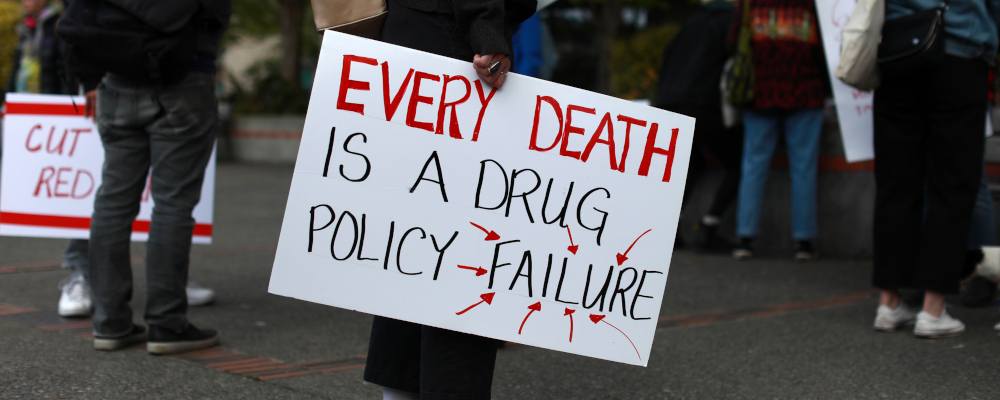Imagine you’re an army general who’s sent in to turn around a losing war. Things are going badly and the enemy is winning. You change the strategy. Everyone supports your new strategy and thinks it’ll work. But instead of turning the tide, your casualties increase by ten times and you keep losing. And every month the numbers keep getting worse.
That’s the situation Canada is in right now with its harm reduction strategy to mitigate drug overdoses. Casualties continue to climb. The enemy is winning. It’s getting worse and there’s no end in sight. Implemented with the best of intentions many years ago, it’s now time for governments to admit failure and find a new strategy.
Everyone concerned with those affected by this scourge starts in the same place—one of caring and wishing to solve this problem for the benefit of the afflicted men and women. We can surely agree on that much and not cast aspersions on the motives of those who disagree over the best method to help addicts. No one from anywhere on the spectrum wants anything other than to reduce the damaged and lost lives, but are we really helping with harm reduction?
What is harm reduction?
Harm reduction is a broad term that describes addiction management protocols that seek to reduce the harms associated with substance use. It does not require abstinence. The focus is on the individual’s behaviour, not on their substance use. In simpler terms, harm reduction maintains the addiction but in a safer, manageable way.
At the field level, practical and low threshold programs are employed. What started with needle exchanges now includes the prescription of heroin and other drugs under the heading “safe supply”, outreach programs, law enforcement cooperation, and safe injection sites.
The numbers tell the story
There are only three performance metrics that are relevant: the number of addicts, the number of overdoses, and the number of overdose deaths. The numbers tell the story. If the strategy works, all three should stabilize or decline. Otherwise, the strategy doesn’t work. It’s as simple as that. The tough question for the advocates of harm reduction is this: if harm reduction is effective, then why have the numbers gone in the wrong direction?
Let’s focus on the most serious metric. Accidental overdose deaths in British Columbia were stable between 2002 and 2010 at just over 200 per year. That was an unacceptably high number at that time and so B.C. went full bore into harm reduction in the late-2000s, as did the federal government post-2015. The numbers soon started to track upward. By 2021, the annual casualty number in B.C. had increased ten-fold to over 2,200.More than 2,200 British Columbians lost to illicit drugs in 2021 https://news.gov.bc.ca/releases/2022PSSG0010-000188#:~:text=The%202%2C224%20total%20number%20of,was%2042.8%20per%20100%2C000%20residents.
In 2004, Toronto recorded 82 accidental overdoses. A few weeks ago, the public health authority just announced that 2021 was the worst year ever for overdoses at 511. Since 2004, we’ve gone from 82 to 511 deaths per year in Toronto, a gruesome 623 percent increase.Toronto Public Health releases preliminary data of confirmed opioid overdose deaths in 2021 https://www.toronto.ca/news/toronto-public-health-releases-preliminary-data-of-confirmed-opioid-overdose-deaths-in-2021/
Nationally, the number of overdose deaths by opioids increased by 284 percent from 2,287 in 2016 to 6,500 in 2020. From the end of 2015 to late 2021, almost 27,000 Canadians have died from opioid overdoses. In terms of hospitalizations for overdoses, across Canada (excluding Quebec) there were 5,240 cases in 2020, the highest reported number since 2016.Opioid- and Stimulant-related Harms in Canada https://health-infobase.canada.ca/substance-related-harms/opioids-stimulants/
These numbers were all on a rapidly increasing trajectory well before the Covid pandemic. Fentanyl also played a large part in these increases. However, harm reduction, if a good strategy, should be agnostic to the drug and the source of the addiction. If Fentanyl is defeating the strategy—if the enemy has a new weapon—then a new strategy is needed all the more.
Advocates repeat the same lines about de-stigmatizing drug addiction and treating drug use as a health problem, not a law enforcement one, and call for full legalization. Fine. The thing is, Canada has been doing that for years under the harm reduction strategy.
We’ve had de facto legalization already implemented in Toronto. A supporter of legalization, Toronto Police Chief James Ramer, was recently asked about his views on the overdose crisis: “We haven’t been charging people for simple possession since November 2020, and yet we received 1,300 more calls for overdoses in 2021 than we did in 2019.”Police chief James Ramer on the push to decriminalize drug possession https://torontolife.com/city/all-the-marijuana-charges-we-laid-back-then-seem-so-ludicrous-to-me-now-james-ramer-the-interim-police-chief-on-the-push-to-decriminalize-drug-possession/ The potential causal connection between those two facts seems lost on him. Perhaps a little more street-level, anti-drug enforcement might actually save lives.
We need a new strategy
At the request of the B.C. government, the Trudeau government, a big supporter of harm reduction, recently announced plans to legalize small amounts of hard drugs like cocaine and heroin.B.C. applies for decriminalization in next step to reduce toxic drug deaths https://news.gov.bc.ca/releases/2021MMHA0059-002084 Advocates of harm reduction want them to go further with the complete legalization of all drugs.
Canada desperately needs to change course. A new strategy must be debated and determined not only by public health experts but by a wide selection of professionals, officials, agencies, political and community leaders, and yes, local citizens groups whose businesses and neighbourhoods bear the brunt of the ancillary effects of the epidemic such as crime and vagrancy.
Change is needed, and yet the only change that authorities are keen to consider is providing more harm reduction—more injection sites, more and different drugs handed out, and less law enforcement. They’re doubling down on the same losing hand.
Another way is possible. Alberta, which in contrast has prioritized a range of prevention, intervention, treatment, and recovery services,Recovery-oriented Overdose Prevention Services Guide https://open.alberta.ca/dataset/e9f7801b-387d-4003-b4e5-2073cd88fd90/resource/159b4628-1a23-4a74-b8df-56e5d647d8aa/download/health-recovery-oriented-overdose-prevention-services-guide-2021.pdf is seeing positive results in decreasing opioid-related fatalities.Opioid deaths down significantly in March 2022 https://www.alberta.ca/release.cfm?xID=82727A43C6C60-0E2C-97D5-28EDF246132507B9
The colloquial definition of insanity is doing the same thing over and over but expecting a different result. But with 27,000 deaths later and no end in sight, we need to stop the tragic insanity of harm reduction.
Recommended for You

Carney gets a majority, but Canadians vote the Liberals out in a snap election: The Hub predicts 2026

Supply management will be sacrificed to appease Trump, and the Netflix takeover is bad for Hollywood: The Hub predicts 2026

Canada will attempt to join the EU and Justin Trudeau becomes a Katy Perry lyric: The Hub predicts 2026

I was an early supporter of B.C.’s Indigenous rights laws. Here’s why I’ve changed my mind



